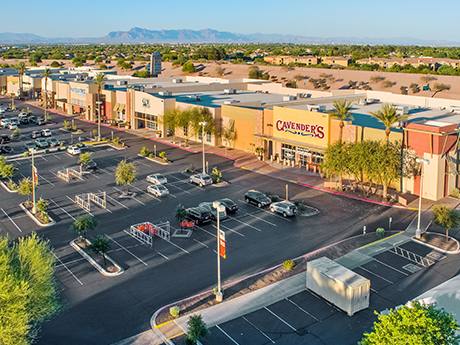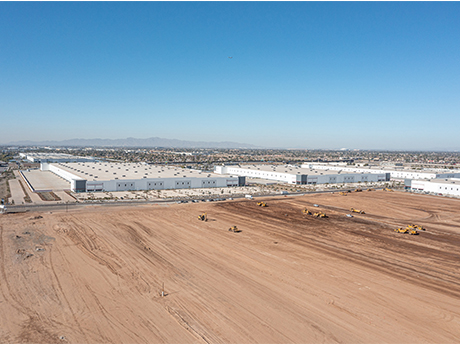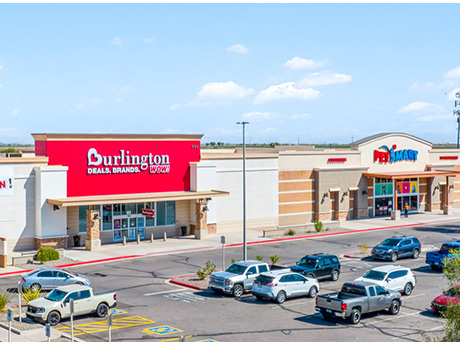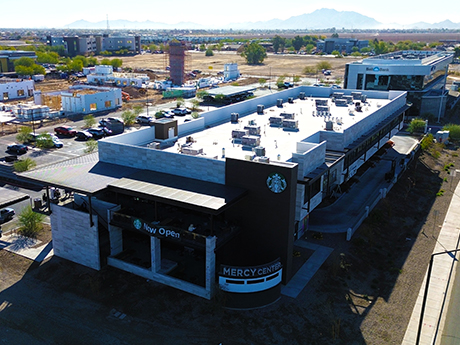— By Bryan Ledbetter of Western Retail Advisors — Phoenix’s retail market continues to surge. Vacancies are dipping below 5 percent, gross absorption is exceeding 1.5 million square feet in the third quarter and asking triple-net rates continue to increase, reaching into the mid-$50 to $60 per square foot range for newly constructed space. West Valley Leads the Charge in New Development After decades of limited retail construction, metro Phoenix — and the West Valley, in particular — are flush with new space. Projects like SimonCRE’s Prasada in Surprise and Vestar’s Verrado in Buckeye are among the major new developments providing the high-end availability that tenants and residents have been asking for. Although elevated debt and construction costs have tempered new development, more than 1.2 million square feet is still under construction. The lion’s share of that product is already pre-leased. This keeps developers and investors bullish on Phoenix, and on the lookout for the Valley’s next development frontier. Though the West Valley reigns as Phoenix’s latest retail boom market, outliers in the East Valley are teeing up for their turn in the spotlight. Apache Junction is a great example… Far Southeast Valley Emerges as a Growth EngineA neighbor of …
Market Reports
— By Todd Hamilton of Citywide Commercial Real Estate — The Phoenix industrial market has felt like a game of pause and play over the past 12 months. A year ago, the sector hit pause amid election uncertainty. Post-election hopefulness reignited activity, but tariffs triggered another slowdown. Then came summer, which is always transactionally slow in Phoenix. This pattern was especially pronounced in the mid-size industrial segment, which was dominated by properties with less than 100,000 square feet. Typically owned by mom-and-pop investors or regional players, these groups lack institutional backing and are more sensitive to factors like interest rates, rising product costs and recession chatter. Despite the unpredictability, Phoenix industrial space has maintained its trademark resilience. Rents grew 4.7 percent year over year, per CoStar’s latest market report, while 787 sales were completed in the past 12 months, at an average price of $180 per square foot. Large-scale inventory (buildings 400,000 square feet and above) has also enjoyed a recent resurgence. At the start of the year, we were wringing our hands over multiple vacant, million-plus-square-foot buildings. Since then, five of those buildings have been leased or sold, with full occupancy expected by year-end. That activity accounts for a …
— By Jason Price of Commercial Properties Inc./CORFAC International — The Phoenix office market continues to show balance as leasing patterns shift and tenants prioritize smaller footprints. The metro’s office inventory totals 195.5 million square feet across roughly 9,000 buildings. Construction has edged upward year over year, with a little more than 900,000 square feet currently underway compared with 844,000 square feet a year ago. Another 1.5 million square feet is expected to deliver between 2025 and 2026, a restrained pace that should help prevent oversupply. This discipline has become critical as companies continue to right-size and lenders remain cautious. The overall market faces slower demand for large contiguous blocks, limited financing availability and an elevated level of sublease inventory that will take time to absorb. Most of the sublease space consists of second-generation Class A and B product in downtown and the Camelback Corridor, where tenants are evaluating long-term space requirements before recommitting. Even so, Phoenix’s fundamentals remain relatively healthy compared with many other metros. The city’s diversified economy, steady population inflow and expanding employment base continue to support leasing activity, particularly for move-in-ready suites of less than 10,000 square feet. Small-business confidence and the return-to-office movement among local …
— By Brett Meinzer of MMG Real Estate Advisors — Despite ongoing challenges, Phoenix’s multifamily market is showing signs of stabilization and strength in key areas. Record Demand, Even in a Cooling Market In first-quarter 2025, net absorption reached 5,149 units, more than double the 10-year quarterly average and the second-highest quarterly total on record. On a 12-month basis, the market absorbed 18,413 units, setting a new high. “We’re seeing demand return to peak levels,” said Brett Meinzer, advisor at MMG Real Estate. “The number of units leased in the last year shows Phoenix’s long-term story remains intact.” Supply Is Slowing, Signaling Potential Stabilization While new supply remains elevated, the pace is shifting. First-quarter deliveries declined 36 percent from the prior quarter, and the development pipeline is now nearly 50 percent below its recent peak. “After years of heavy deliveries, the pipeline is thinning,” Meinzer said. “This pullback could help stabilize rent and occupancy rates as we head into 2025.” Rent Trends Still Negative But Improving Phoenix’s effective rent currently stands at $1,560, down 2.3 percent year over year, with average occupancy at 91.9 percent. Rent softness is largely driven by concessions and intense lease-up competition from new construction. However, …
By Nellie Day Metro Phoenix’s population grew to include more than 5 million people in 2023, per the Census, making it the second fastest-growing large U.S. city that year. This increase in residents and employment opportunities naturally brought new, emerging and different retailers to the area, who quickly occupied both existing centers and new developments. Phoenix-headquartered Vestar’s activity paints a picture of how this retail market has grown with its population. In the last quarter of 2024 alone, Vestar broke ground on Verrado Marketplace, a 500,000-square-foot shopping center in Buckeye; ushered in a new wave of tenant openings at Las Tiendas Village in Chandler and Queen Creek Marketplace in Queen Creek; and brought back a seasonal pop-up inside a 50-foot spherical dome at the District at Desert Ridge Marketplace in Phoenix. Balancing Tenant Mix, Community Relevance The key to capitalizing on Metro Phoenix’s growth, the firm says, is focusing on tenant diversification and market positioning. Vestar actively seeks out curated tenant mixes that not only attract foot traffic but align with the demographic and economic profiles of each community. Las Tiendas Village, for example, recently welcomed Marshalls, beauty supply store Happy Beauty, luxury lash spa Revelashons and child-focused hair salon …
— Phillip Hernandez, Research Director, Colliers — The Phoenix industrial market showed resilience throughout 2024. Arizona ranked fifth in net migration as of October, with 62,533 new residents — 52.8 percent of whom relocated from California. This influx of residents has positively impacted the labor market, growing Phoenix’s workforce by 42,900 employees by November, a 1.7 percent increase from the previous year. Investor interest in Phoenix’s industrial sector also remains strong. Fourth-quarter sales volume reached $1.9 billion, a 74 percent increase compared to the previous quarter and a 91.8 percent year-over-year increase. This brought last year’s total sales volume to $4.3 billion, with average prices per square foot rising by 2 percent (to $204.20) compared to fourth-quarter 2023. Vacancy Trends and Absorption Despite strong investor activity, the Phoenix market is experiencing rising vacancy rates. New deliveries in the fourth quarter added 7.8 million square feet to the market, bringing total deliveries for 2024 to 34.8 million square feet. However, the vacancy rate increased to 10.6 percent, marking a year-over-year 390 basis points rise. This increase is largely attributed to the completion of vacant product. Net absorption reached 3.8 million square feet in the fourth quarter, contributing to a year-to-date total of …
— Dave Carder, Senior Vice President, Kidder Mathews — The state of Phoenix’s office market is not easily summed up with a catchy headline or a few brief bullet points. Along with most large metropolitan areas across the country, Phoenix has struggled with lower demand, rising vacancies and a shift toward hybrid workweeks. However, several emerging trends are creating positive shifts in the market that should be noted as we look to 2025 and beyond. The average vacancy rate of the Phoenix office market over the past decade was 18.5 percent. That includes a low of 13.9 percent in 2019 and a high of 24.8 percent in 2024. Gross leasing absorption averaged nearly 7 million square feet annually, with a high of nearly 7.9 million square feet in 2019 and a low of 5.5 million square feet last year. Net leasing absorption showed a similar pattern, peaking at 3.1 million square feet in 2019 and declining to negative 2.2 million square feet in 2024. These trends point to 2019 being the market’s best-performing pre-pandemic year across all three metrics. Despite 2024’s gross leasing absorption (5.5 million square feet) being close to the 10-year average, the significant rise in vacancy and …
— By John K. Jackson of Colliers Phoenix — Casa Grande, Ariz., stands at a pivotal juncture that could see it transition into a Tier II retail market this year. Phoenix’s Greater Metropolitan Area has been characterized by historically low retail vacancy rates, prompting retailers and developers to explore opportunities outside the urban core. Casa Grande’s strategic location less than 50 miles south of Phoenix Sky Harbor International Airport makes it well-positioned to capitalize on this migration. The Dynamics of Casa Grande’s Growth Casa Grande has experienced notable growth in recent years. It was the seventh fastest-growing U.S. city in 2021, experiencing a remarkable 24 percent population increase since 2016. This growth, paired with job creation across sectors, is attracting major employers, including Lucid, LG Energy Solution and Kohler. These three firms promise to collectively bring more than 6,400 jobs to the area. Such economic development lays a solid foundation for retail expansion. After all, a growing workforce typically leads to increased consumer demand. The significant investments being made in the area further bolster Casa Grande’s potential as a retail hub. Lucid has recently expanded its manufacturing complex to 4 million square feet, with plans for additional land acquisition to support …
— Scott Hintze and Marti Weinstein of Diversified Partners Commercial Real Estate — Phoenix’s retail development market is seeing a surge in optimism as the city benefits from a growing economy and a shift in political leadership. With the new administration coming into power, the outlook for the Phoenix retail market has become increasingly positive, promising a wave of new projects and investment opportunities in the coming years. The city’s rapid population growth, expanding infrastructure and bustling job market have positioned Phoenix as one of the most attractive cities in the U.S. for retail development. The new administration has brought a renewed focus on urban development, job creation and business-friendly policies, which is expected to help stimulate both demand for retail spaces and the construction of new commercial properties. Government support, including incentives for developers and tax breaks for businesses, is anticipated to foster a thriving retail sector that will benefit both local residents and national retailers looking to expand into the area. Several projects we have been working on have seen unprecedented demand from tenants. We recently completed a 25,000-square-foot building across from Gilbert Mercy Hospital that includes a two-story Starbucks, the first in the market. In addition to …
— By Brett Polachek of Newmark — Phoenix’s multifamily market experienced dynamic shifts in 2024, driven by strong population growth, economic expansion and single-family cost of ownership. Phoenix remains a top relocation destination, with a population growth rate of 1.8 percent (+85,000 residents), nearly double the national average of 0.98 percent. This influx is supported by the addition of more than 52,000 jobs from October 2023 to October 2024. Phoenix also has the fifth healthiest rent-to-income ratio among 30 major U.S. markets that we sampled. Demand for multifamily housing reached record levels, with 14,528 units absorbed annually, marking the strongest performance since 1994. The supply experienced an annual increase of 6.4 percent as 19,835 units delivered last year. The far West Valley submarkets of Avondale, Goodyear and West Glendale led supply growth, adding 6,100 units to their inventory. The market showed resilience despite this historic supply wave. Occupancy rose 1 percent year over year to 93.7 percent, while Class B units clocked in a 94 percent occupancy rate. This was followed by Class A at 93.8 percent and Class C at 93.2 percent. These figures remain slightly below pre-pandemic levels, but they reflect a strong recovery trajectory. Asking rents in …
Newer Posts






